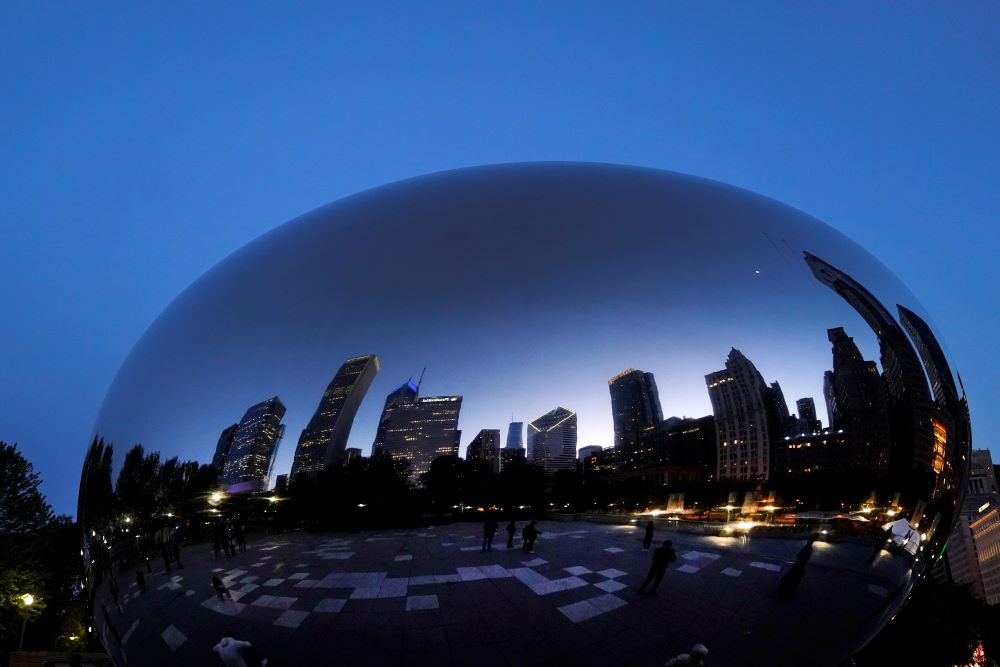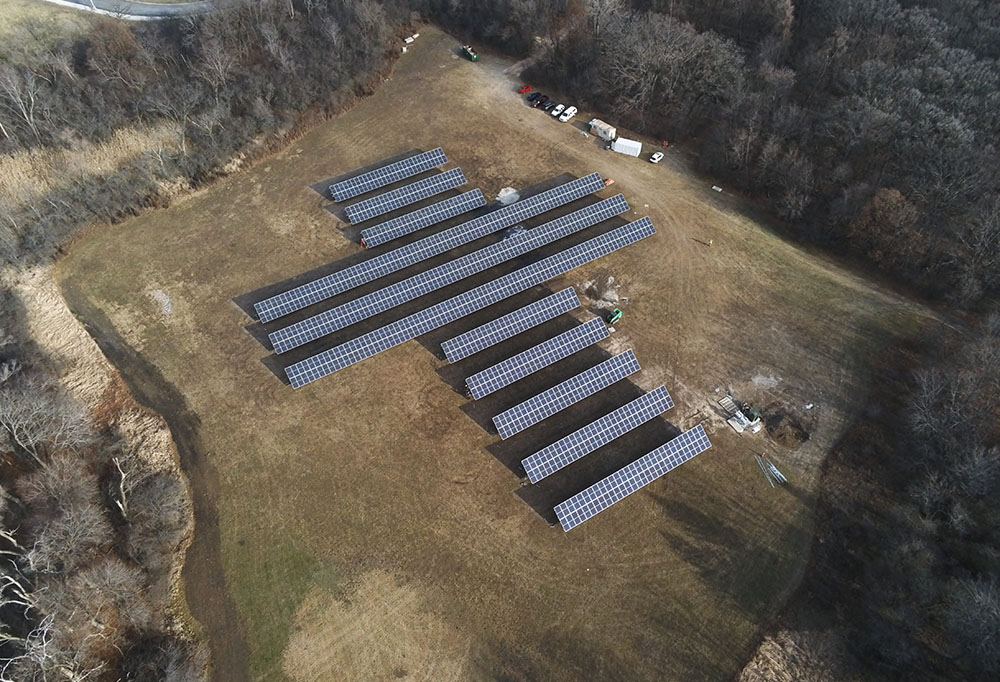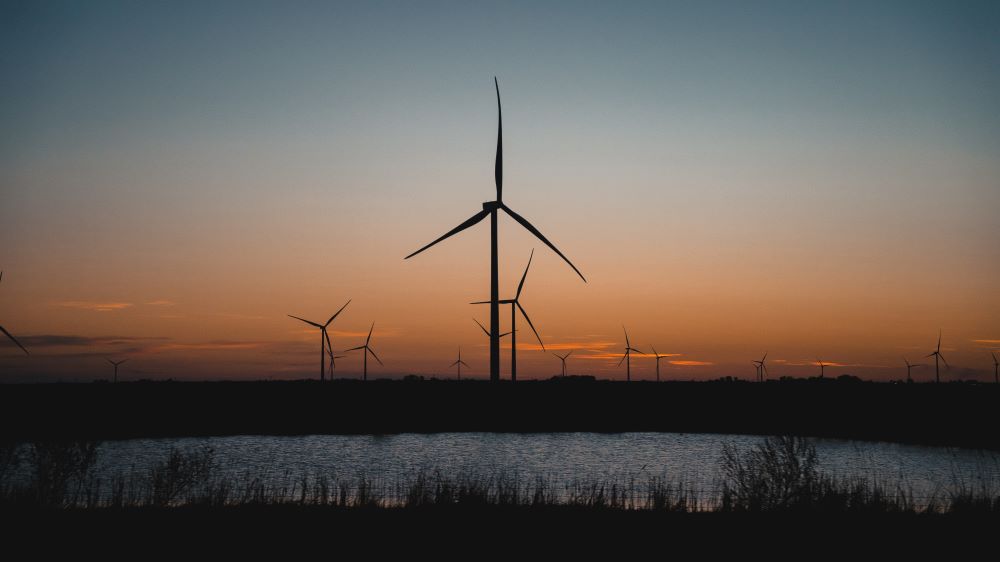
The Chicago Archdiocese announced Dec. 17 that beginning in January its nearly 400 parishes, schools, cemeteries and offices will switch to 100% renewable energy sources for its electricity needs. Here, the Chicago skyline is reflected on Anish Kapoor's stainless steel sculpture Cloud Gate, also known as "The Bean," in the city's Millennium Park Thursday, May 25. (AP/Charles Rex Arbogast)
The power of the wind will soon fully power the Catholic Church in the Windy City.
The Chicago Archdiocese announced Dec. 17 that beginning in January its nearly 400 parishes, schools, cemeteries and offices will switch to 100% renewable energy sources for its electricity needs.
Through its energy supplier Direct Energy, the archdiocese has purchased enough renewable energy certificates, or RECs, to cover the electricity consumption for the coming year for the more than 2,000 buildings under its purview.
Each REC represents one megawatt-hour of electricity generated from a renewable source. Third-party power generators earn RECs for the renewable energy they produce, which they then can sell or trade to utilities, companies and institutions that want electricity from sources other than fossil fuels — whose burning releases heat-trapping greenhouse gas emissions that are the primary driver of climate change.
'As an expression of our commitment to the sanctity of life, the Archdiocese of Chicago has chosen to do all we can to ensure generations to come have a future.'
—Cardinal Blase Cupich
According to the archdiocese, which buys power in bulk for all its facilities, their RECs represent the annual equivalent of removing 15,000 cars from the road or the carbon emissions generated from 8,500 homes' total energy use.
(The U.S. Environmental Protection Agency features a Greenhouse Gas Equivalencies Calculator, which allows users to calculate energy measurements into terms such as the annual emissions from cars, households or power plants.)
The renewables behind the archdiocese's certificates are almost entirely wind — though from across the Midwest, not just produced within the Windy City.
The announcement of the move to renewable power was timed to the 87th birthday of Pope Francis, who has made ecological concern a pillar of his decade-long papacy. In a statement, Chicago Cardinal Blase Cupich said that the pope's message to the just-concluded United Nations climate summit, COP28, reminded everyone that "the future of us all depends on the present that we now choose."
Chicago Cardinal Blase Cupich (OSV News/Gregory A. Shemitz)
"As an expression of our commitment to the sanctity of life, the Archdiocese of Chicago has chosen to do all we can to ensure generations to come have a future," Cupich said.
Archdiocesan discussions of shifting to renewable energy for electricity picked up in the latter half of this year and included Cupich and other senior-level officials.
"We are always looking for ways to leave a smaller footprint on the world with our parishes and schools," said Eric Wollan, the archdiocese's chief capital assets officer. He told EarthBeat the switch to renewable energy for electricity is part of a two-pronged approach to find ways to lower the archdiocese's carbon footprint while continuing to find ways to reduce overall energy usage throughout its buildings.
"We wanted to do something that had an immediate impact for sure across the entire diocese, and this was clearly the most direct way to do that while we continue to advise parishes and schools on other energy savings," he said.
In the past 36 months, the Chicago Archdiocese has replaced more than 50 boilers in parishes and schools, investing tens of millions of dollars to swap old and inefficient systems with modern versions. Over the years, it has worked with parishes to benchmark their energy usage, and in January plans to start a series of energy audits through their energy providers to identify other projects to improve efficiency and reduce use.

A 300-kilowatt solar energy project went into commercial operation Dec. 25, 2021, on the campus of the University of St. Mary of the Lake/Mundelein Seminary in Mundelein, Illinois. (UMSL/Mundelein Seminary)
On Christmas day 2021, the University of St. Mary of the Lake in Mundelein, the archdiocese's seminary and graduate school, flipped the switch on a 300-kilowatt, cross-shaped solar array — the only solar installation at a U.S. seminary, which is projected to save $1 million in utility costs over 35 years.
Other dioceses in the U.S., including Baltimore and Washington D.C., have also developed programs to offer renewable power to their parishes and schools.
Dan Misleh, founder of the Catholic Climate Covenant, said such moves are "a very clear signal" of the church living up to Francis' urgent calls "that we have to get a handle on this climate crisis," as laid out in the pope's 2015 encyclical "Laudato Si', on Care for Our Common Home" and his recent follow-up Laudate Deum. In that latter papal teaching document, Francis pressed nations to speed up "the necessary transition towards clean energy sources such as wind and solar power, and the abandonment of fossil fuels."
"I think Pope Francis was very clear in Laudate Deum that we need to step up and take this issue seriously," Misleh said. "So I think the fact that an archdiocese as large as Chicago has done this is very significant. And I'm hoping that more dioceses will follow suit."
John Mundell, director of the Vatican's Laudato Si' Action Platform, agreed the Chicago Archdiocese's move reflects the kind of change that Francis seeks from the church in response to climate change.
"Going 100% renewable is a decisive step on the journey of ecological conversion, and the Chicago action is a sign of encouragement to dioceses worldwide," he said in an email.
Guided by its care for creation ministry, the Chicago Archdiocese is one of the 183 dioceses globally to enroll in the Laudato Si' Action Platform. The initiative of the Dicastery for Promoting Integral Human Development invites Catholic institutions to develop seven-year plans to take concrete actions around sustainability and ecological spirituality. Suggested steps include reducing food and plastic waste, educating on environmental issues and utilizing clean energy.

(Unsplash/Tianxiang Ji)
Becky Menich, a member of the creation care committee at St. Anne Catholic Community, in Barrington, said the archdiocese adopting renewables is "going to make this instant, huge impact" in meeting the goals outlined in the Vatican sustainability initiative.
"We are called to action, and this is action," she said.
The Chicago Archdiocese's switch to renewable energy, though, comes with higher electricity bills. While that cost will vary depending on the building, archdiocesan officials estimate it at less than 3%.
Wollan told EarthBeat they anticipate that bills will decrease as renewable energy sources expand and their costs continue to decline. Globally, clean energy costs have plummeted in the past decade and already are cheaper than power generated from coal, oil or gas. Energy analysts project by 2030 costs for wind power will fall 25% and by half for solar.
For Tony Quintanilla, a parishioner at Evanston's St. John XXIII Parish and a member of its creation care committee, the small additional cost for clean power is worth it. He and his wife pay a $9 premium on their monthly bill for wind energy to provide their electricity, and they have worked to shift appliances from gas to electric.
A former member of his parish's school board, Quintanilla said he understands that even a small increase can pose challenges to some parishes. He suggested resources could be shared through the archdiocese to help churches with tight budgets.
He told EarthBeat the archdiocese's move to renewable energy raises awareness of church teaching on creation care and boosts efforts at the parish level.
Advertisement
"It gives us hope that our efforts can really pay off and that we can make a difference in responding to the pope's call to care for creation and care for our common home, which ultimately means caring for each other. You know, it's really just part of the Gospel message," he said.
The shift to renewable energy won't halt other efforts the archdiocese is making to reduce its power use. Wollan said they'll continue working to shrink the amount of natural gas it consumes for heating by replacing more boilers. And while solar power has proven difficult at the parish level, the archdiocese has explored large-scale projects at vacant land sites it owns.
Such steps can raise awareness around church teaching on creation care, he told EarthBeat, and maybe inspire others to make sustainable moves in their own homes and businesses.
"You hope there's a multiplier effect, right?" Wollan said. "That people see the Archdiocese of Chicago and its parishes living — not just speaking and conveying the wishes of Pope Francis and Cardinal Cupich and others — but really living that out."








